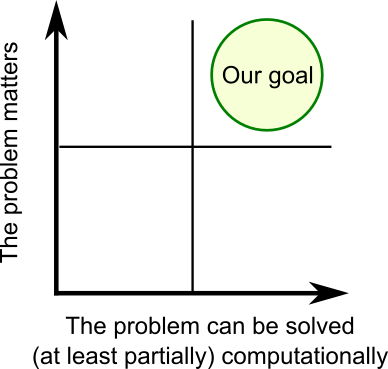Spotting problems that both matter and are computationally solvable
Derek Lowe’s blog post Calculating your way to antivirals is an interesting read about his reflection on computation (docking in particular) in drug discovery. Here are my learning notes and reflections.
- My summary of the blog post
- Working on problems that matter and that can be solved computationally
- Conclusions
The blog post was about an article published on New England Journal of Medicine, How to Discover Antiviral Drugs Quickly.
My summary of the blog post
The key message I got from the post is that virtual screening of drug-like molecules is an useful technique in drug discovery, but it is not all about drug discovery. Attempts to accelerate this process are welcome, but they alone are far from being sufficient.
There are two main arguments. First, computational docking between proteins and drug-like molecules involves invariably a long list of simplifications, approximations, and trade-offs. A successful molecular modelling project requires much more than computation resources - expert knowledge of the modeller and target-specific heuristics matter probably even more.
Second, the outcome of the modelling needs critical assessment by experiments. In fact, increasing computational power does not save much time, because the large bulk of real work comes after the screening: medicinal chemists have to optimize the potency, selectivity, PK profiles such as metabolic stability and clearance, and safety/toxicity profiles. Computational approaches can help with some aspects, but not all and not always.
His final sentence about making molecular modelling faster was particular vivid: “it’s like cutting a couple of minutes off your trip to the airport to catch a six-hour flight.&rduo;
Working on problems that matter and that can be solved computationally
I agree with Derek’s opinions about docking and virtual screening. At the same time I see the huge potential of computation in drug discovery. The way to fulfil the potential, however, is not via more computational resources, but via better modelling and understanding of biological and chemical systems.
My experience and my belief is that mathematical, statistical, and computational modelling approaches are complementary to experimental approaches in drug discovery. They are already indispensable in some aspects (for instance target identification and in silico screening of toxicity). We should not have any illusion, though, that they will in near future substantially shorten the time or save the resources (say, to the one tenth of what we need now) required to develop new drugs, to get them tested in the clinic, and to get them approved.
On the other side, I do believe that computation, or more specifically, multiscale modelling in drug discovery, an integration of mathematical, statistical, and computational modelling at molecular, cellular, body, and population level, is already helping us finding better drugs. And the assistance and augment we can rely on will only get better.
The main achievement and improvement brought by multiscale modelling does not come with the increase of computational resources. Instead, it comes mainly from two other sources. On one hand, the improvement comes with the accumulation of high-quality, reliable data in biology and chemistry from which we can draw causal inferences, our capacities to convert data into knowledge, and to use the knowledge to design new experiments, the results of which can update our believes of good ways to modulate biological systems, where ‘good ways’ means drugs with reasonable efficacy and safety profiles. On the other hand, the improvement comes with computation-assisted investigations of further serendipities, like the many ones including Penicillin and sidenafil (more widely known as Viagra) that we human beings have fortunately got. These are ‘deterministic’ and ‘stochastic’ factors, respectively, of how multiscale modelling may help us discovery more and better drugs.
The road, alas, is not as straightforward as buying more CPUs and memories and accumulating more data. A lesson I draw from Derek’s post is that as computational scientists working in drug discovery, we should strive to spot questions that really matter and that can be solved with the help of mathematical, statistical, and computational approaches. The computational resources and the specific techniques, let it be mathematical modelling, statistical learning, or computational simulation, do not really matter in the end. Effective communication and collaboration with non-computational experiments and problem solving are the A and O of computational science in drug discovery.
Conclusions
I summarize my thoughts in a simple illustration.

It matters not how much hardware we churn or how much software we build. We need to better describe, predict, and understand biological systems. Along the way, we must spot questions that matter and questions that be solved (at least partially) computationally, and work hard on the intersection of both sets.
I am curious to find out whether such an implementation of computation and multiscale modelling would lead to better decisions and better drugs.